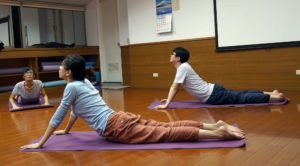1. Tra’taka yoga controls the ocular foresight. The yoga can lead to few mystical powers.
2. Asanas are easy, calm and quite postures that are held with proper breathing. The positions exercise glands, sub-glands, nerves, tissues and organs of the body. By practicing asanas regularly people can keep their body healthy and cure several physical and mental diseases. While practicing Asanas, yoga poses glands are controlled, which control secretion of hormones. Finally, the hormones’ secretions control propensities, emotions. Thus, regular practices of yoga poses help people to balance body and focus the mind.
3. Mudras are positions that exercise the muscles and nerves. Mudras means externalization of internal ideation. In few spiritual mudras are exceptions where the internal ideation is not externalized. People may or may not get physical comfort and mental calmness like asanas.
4. Bandhas are posture that exercise only nerves. People may or not feel physical comfort and mental calm. Bandhas influence the flow of vayus, vital energy flow of the body.
5. Vedhas are approximately the same as bandhas. Vedhas exert little effect on the nerves and flow of vital airs.
6. Pratyahara is a part of yoga practice where the yogis withdraw their mind from external objectivity and directing them to the Supreme Consciousness.
7. Pranayam is a process of breath control with the ideation of the Supreme Consciousness. The process helps the mind in focusing and meditation.
8. Dharana means to locate the mind firmly in a region of the body. It involves concentration on the respective controlling points of the five fundamental factors with cosmic ideation.
9. Cakrashodhana means purification of the cakras by concentrating on the cakras, psychic energy centers with the cosmic ideation. It is not a part of the Astaunga Yoga.
10. Dhyana means the constant flow of mind to the Supreme Consciousness.
11. Samadhi is the result of the spiritual practice in which the unit consciousness merges with the Supreme Consciousness.
a. Saviklpa Samadhi is a temporary stage of samadhi when the aham and citta merge into Mahat.
b. Nirvikalpa Samadhi is a permanent stage of samadhi when the mahat merges into the atman.
12. Diiksa is the process of initiation. Personal mantras and cakras are prescribed during initiation by Acaryas, spiritual yoga teachers.
RAJADHIRAJA YOGA
YOGA AND MEDITATION CLASSES FOR BODY AND MIND

